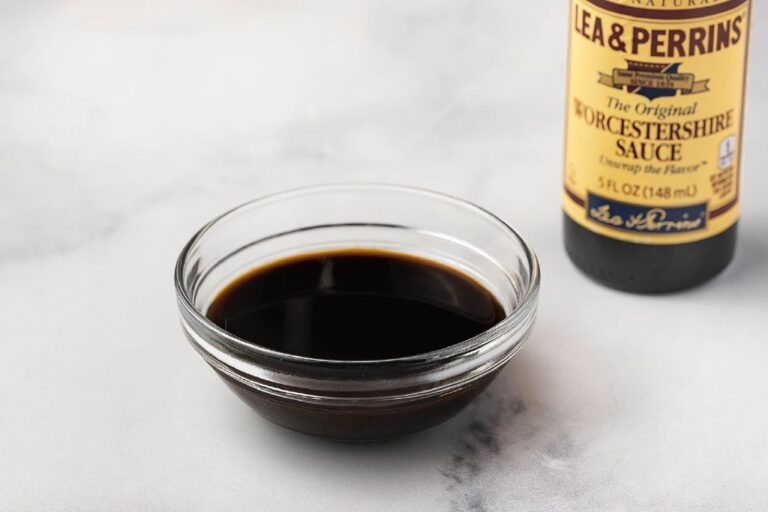Is Fish Sauce and Oyster Sauce the Same? What’s the Difference?

Are you a fan of Asian cuisine? Do you find yourself savoring the rich, complex flavors that make these dishes so extraordinary? If so, you’ve likely encountered two popular ingredients: fish sauce and oyster sauce.
At first glance, they may seem similar, both with their umami-packed profiles. Let me tell you, there’s more than meets the eye—or rather, the taste buds.
In this culinary exploration, we’re diving deep into the realm of fish sauce and oyster sauce. We uncover their secrets and discover the nuances that set them apart.
So, buckle up and get ready for a flavor-filled journey as we unravel the age-old question: Are fish sauce and oyster sauce the same, or is there a world of difference between them?
Get ready to tantalize your taste buds. Learn how these two extraordinary sauces can elevate your culinary creations to new heights.
Fish Sauce
Fish sauce, a staple in Southeast Asian cooking, is a condiment made from fermented fish. It has a long history dating back thousands of years and is used in countries such as Thailand, Vietnam, and the Philippines.
Making fish sauce involves salt-fermenting whole fish, usually anchovies or small fish. The mixture is then left to ferment for several months, resulting in a pungent, amber-colored liquid.
The unique flavor profile of fish sauce can be described as salty, savory, and slightly fishy. Although the initial smell of fish sauce can be off-putting, its taste enhances the umami factor in dishes, adding depth and complexity.
Fish sauce is often used as a seasoning or marinade and can be found in traditional Southeast Asian recipes, such as Thai curries, Vietnamese pho, and Filipino adobo.
Here is a table highlighting the key characteristics of fish sauce:
| Characteristic | Description |
| Main ingredient | Fermented fish |
| Flavor profile | Salty, savory, slightly fishy |
| Color | Amber |
| Culinary uses | Seasoning, marinade |
| Commonly found in | Southeast Asian cuisine |
Oyster Sauce

Oyster sauce is a thick, dark sauce used in Chinese and other East Asian cuisines. As the name suggests, oyster sauce is made from oysters, specifically their juices. The oyster extract is combined with soy sauce, sugar, and other seasonings, creating a rich and flavorful condiment.
Oyster sauce has a distinct taste characterized by its salty, sweet, and earthy notes. Unlike fish sauce, oyster sauce doesn’t have a prominent fishy flavor. Instead, it offers a rich umami taste that enhances the overall flavor profile of a dish. Oyster sauce is versatile and can be used as a stir-fry sauce, a glaze for roasted meats, or as a flavoring in vegetable dishes.
Let’s take a look at the key characteristics of oyster sauce in the table below:
| Characteristic | Description |
| Main ingredient | Oyster extract |
| Flavor profile | Salty, sweet, earthy |
| Color | Dark brown |
| Culinary uses | Stir-fry sauce, glaze, flavoring |
| Commonly found in | Chinese and East Asian cuisines |
Differences Between Fish Sauce and Oyster Sauce
While both fish sauce and oyster sauce are used to enhance the flavors of dishes, there are several notable differences between the two:
- Main Ingredient: Fish sauce is made from fermented fish, while oyster sauce is made from oyster extract.
- Flavor Profile: Fish sauce has fishy taste more pronouncedly, contributing a salty and savory flavor to dishes. On the other hand, oyster sauce has a milder, sweeter taste with earthy undertones and a rich umami flavor.
- Color: Fish sauce typically has an amber color, while oyster sauce is dark brown in color.
- Culinary Uses: Fish sauce is used as a seasoning or marinade in Southeast Asian cuisine. It adds depth and complexity to dishes like curries and soups. Oyster sauce is often used as a stir-fry sauce, glaze for roasted meats, or as a flavoring in vegetable dishes in Chinese and East Asian cuisines.
- Regional Differences: Fish sauce is used in Southeast Asian countries such as Thailand, Vietnam, and the Philippines. It is a fundamental ingredient in traditional recipes. Oyster sauce, on the other hand, is more prevalent in Chinese and East Asian cuisines.
- Aroma: Fish sauce has a pungent smell due to its fermentation process, which some may find strong. Oyster sauce, in contrast, has a more subtle aroma that is not as overpowering.
- Ingredients: Fish sauce consists of fermented fish and salt. Oyster sauce contains oyster extract, soy sauce, sugar, and other seasonings.
Fish sauce and oyster sauce have their own unique characteristics, but they can complement each other in certain recipes. Some dishes may enjoy a combination of both sauces, adding complexity to the flavors.
Can Fish Sauce Substitute Oyster Sauce in Recipes?
Fish sauce can be used as a substitute for oyster sauce in certain recipes, although it’s important to note that there will be differences in flavor and aroma. Fish sauce has a distinct savory, salty, and umami-rich taste, which can add a unique depth to dishes.
When you replace fish sauce with oyster sauce, consider the overall flavor profile you want to achieve. While both sauces add umami, oyster sauce has a sweeter and milder flavor compared to fish sauce. Therefore, the substitution may alter the taste of the dish to some extent.
Here are a few points to consider when using fish sauce as a substitute for oyster sauce:
- Quantity: Since fish sauce is saltier than oyster sauce, you better use less fish sauce than the amount of oyster sauce called for in the recipe. Start with a smaller amount and adjust according to your taste preference.
- Dilution: Fish sauce can be quite potent, so you may want to dilute it with some water or other liquids used in the recipe. This will help balance the flavors and prevent the dish from becoming too salty.
- More sweetness: If the recipe calls for the sweetness of oyster sauce, consider adding a small amount of sugar or a sweetener. They mimic the slight sweetness found in oyster sauce.
- Experimentation: Cooking is often a creative process, and substituting ingredients allows for experimentation. Feel free to adapt the recipe to your taste preferences. Doing so by adjusting the other seasonings, herbs, or spices to achieve a balanced and flavorful dish.
INFO
The substitution of fish sauce for oyster sauce works better in dishes where fish sauce is already a common ingredient. It tastes better in cooking, such as stir-fries, marinades, soups, or dipping sauces.
It may not be an ideal replacement for recipes that rely on the unique flavor profile of oyster sauce. Some dishes, such as certain Chinese dishes like oyster sauce-based stir-fries, won’t affect its taste prominently
Price Comparison of Fish Sauce and Oyster Sauce
The cost of fish sauce can range from affordable in local markets to premium bottles produced by well-established brands. The affordability of fish sauce is often attributed to the widespread availability of fish and its production process. However, premium fish sauce, which has longer fermentation periods and utilizes high-quality fish, can command a higher price. This is a result of its superior flavor and craftsmanship.
Oyster sauce presents a distinct flavor profile. It combines the savory umami taste of oysters with the richness of soy sauce and other seasonings. The price of oyster sauce can vary based on factors such as the quality and quantity of oysters, the production process, and the brand value.
Oyster sauce, compared to fish sauce, tends to be more expensive. This is mainly due to the higher cost of oyster extraction and the higher number of ingredients used in its production.
Oysters are considered a delicacy. Their availability and pricing can fluctuate depending on factors such as seasonality, farming practices, and geographical location. These factors contribute to the overall cost of oyster sauce, making it relatively pricier compared to fish sauce.
Vegetarian or Vegan Alternatives to Fish Sauce or Oyster Sauce
When it comes to culinary adventures, it’s fascinating to explore the vast array of flavors and ingredients that exist in the world. For vegetarians or living a vegan lifestyle, finding alternatives to condiments like fish sauce or oyster sauce can be a thrilling challenge.
Luckily, there are several mouthwatering alternatives that can mimic the depth and complexity of these traditional savory sauces. Let’s embark on a culinary journey and discover some delectable vegetarian or vegan alternatives that can substitute fish sauce and oyster sauce.
- Soy Sauce: A staple in many Asian cuisines, soy sauce is a versatile and available alternative to both fish sauce and oyster sauce. Made from fermented soybeans, this dark and savory condiment offers a rich umami flavor. Opt for a high-quality soy sauce, such as tamari or shoyu, to ensure a depth of taste that complements a variety of dishes. Whether you’re stir-frying vegetables, marinating tofu, or creating a delicious dipping sauce, soy sauce can be your reliable companion in the kitchen.
- Tamari: Derived from soy sauce, tamari is an excellent gluten-free alternative for those with dietary restrictions. Crafted with minimal or no wheat content, tamari has a smooth and mellow flavor profile. Its umami essence makes it an ideal choice for enhancing stir-fries, noodle dishes, and sushi rolls. Tamari’s distinctive taste lends a touch of authenticity to your creations while keeping them vegetarian.
- Mushroom Sauce: For those seeking a more earthy and robust alternative, mushroom sauce can be a delightful substitute. Harnessing the natural umami essence of mushrooms, this sauce imparts a deep, savory flavor to your dishes. By simmering mushrooms with complementary ingredients like garlic, onions, and herbs, you can create a luscious sauce. This works wonders in stir-fries, pasta dishes, or even as a delightful accompaniment to steamed vegetables.
- Seaweed-Based Sauce: For those who crave a taste reminiscent of the ocean, a seaweed-based sauce can be an excellent choice. This vegan alternative mimics fish sauce or oyster sauce with its briny undertones and umami flavor. Made by infusing dried seaweed with various aromatic ingredients, this sauce can lend depth and complexity to soups, stews, and noodle dishes.
- Fermented Bean Paste: Fermented bean paste, such as miso or fermented soybean paste, is a cherished ingredient in many Asian cuisines. With its rich and savory flavor, this paste brings a unique depth to your dishes. Depending on the variety, miso can range from mild and sweet to robust and salty. Incorporate it into marinades, glazes, or even dressings, and let its complex flavors infuse your creations with a hint of umami.
- Vegetable Broth: An ever-reliable option, vegetable broth can serve as a simple and versatile substitute for fish sauce or oyster sauce. While it may not replicate the exact flavor profile, vegetable broth can provide a savory base for your dishes. Enhance its taste by simmering vegetables, herbs, and spices to create a concentrated stock. Use it as a cooking liquid, flavor enhancer, or as a component in sauces to add depth and complexity to your vegetarian or vegan recipes.
Conclusion
In conclusion, fish sauce and oyster sauce may share similarities in their roles as flavor enhancers. They have distinct differences in ingredients, flavor profiles, culinary uses, and regional preferences.
Understanding these differences helps cooks and foodies choose the right sauce for their dish. So, whether you’re preparing a traditional Southeast Asian recipe or exploring Chinese cuisine, knowing the nuances between fish sauce and oyster sauce can elevate your culinary creations to new heights.






